ICT Research Methods and Principles Report: Data Collection, Analysis
VerifiedAdded on 2021/06/18
|12
|2868
|31
Report
AI Summary
This report provides an overview of ICT research methods and principles. It begins by outlining three qualitative data collection techniques: interviews, focus groups, and artifacts, with a detailed justification for selecting interviews as the primary method for gathering data related to the school of technology and environment at the University of Tasmania. The report then explores three qualitative data analysis techniques: narrative analysis, qualitative comparative analysis, and observational analysis. Qualitative comparative analysis is selected and justified as the most appropriate method for analyzing the collected interview data, emphasizing its ability to compare participant responses and relate them to existing theories. The report highlights the strengths and weaknesses of each method, offering a comprehensive understanding of the research process.
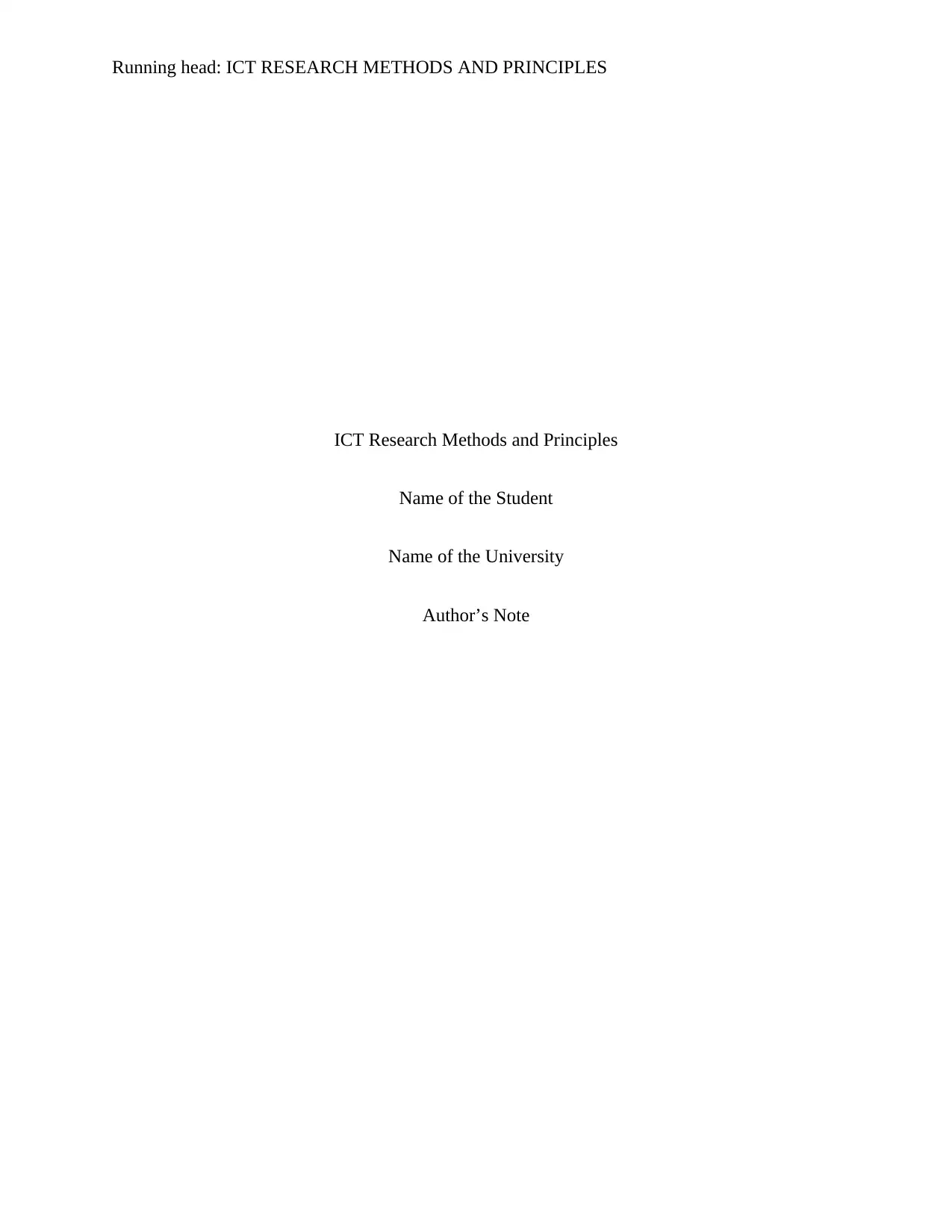
Running head: ICT RESEARCH METHODS AND PRINCIPLES
ICT Research Methods and Principles
Name of the Student
Name of the University
Author’s Note
ICT Research Methods and Principles
Name of the Student
Name of the University
Author’s Note
Paraphrase This Document
Need a fresh take? Get an instant paraphrase of this document with our AI Paraphraser
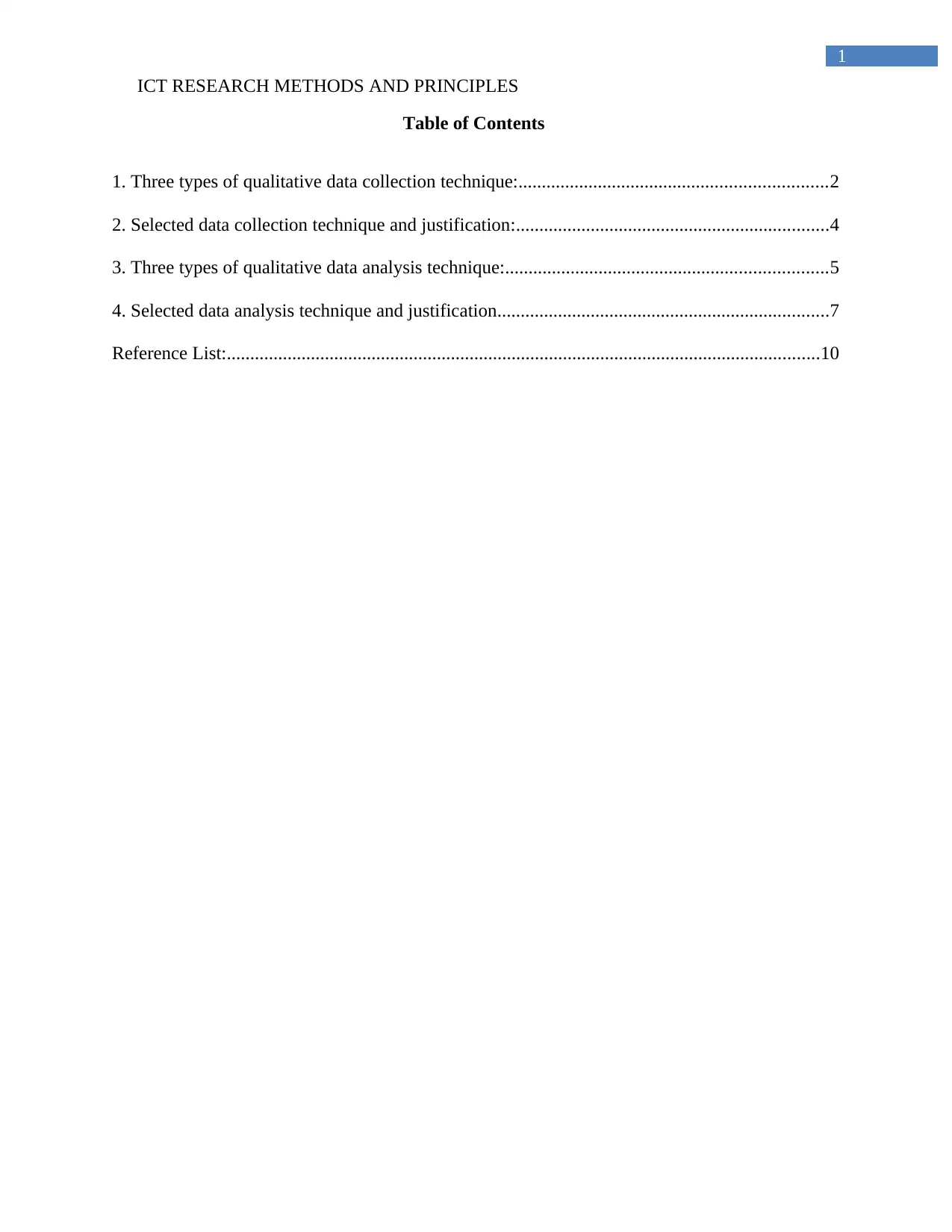
1
ICT RESEARCH METHODS AND PRINCIPLES
Table of Contents
1. Three types of qualitative data collection technique:..................................................................2
2. Selected data collection technique and justification:...................................................................4
3. Three types of qualitative data analysis technique:.....................................................................5
4. Selected data analysis technique and justification.......................................................................7
Reference List:...............................................................................................................................10
ICT RESEARCH METHODS AND PRINCIPLES
Table of Contents
1. Three types of qualitative data collection technique:..................................................................2
2. Selected data collection technique and justification:...................................................................4
3. Three types of qualitative data analysis technique:.....................................................................5
4. Selected data analysis technique and justification.......................................................................7
Reference List:...............................................................................................................................10
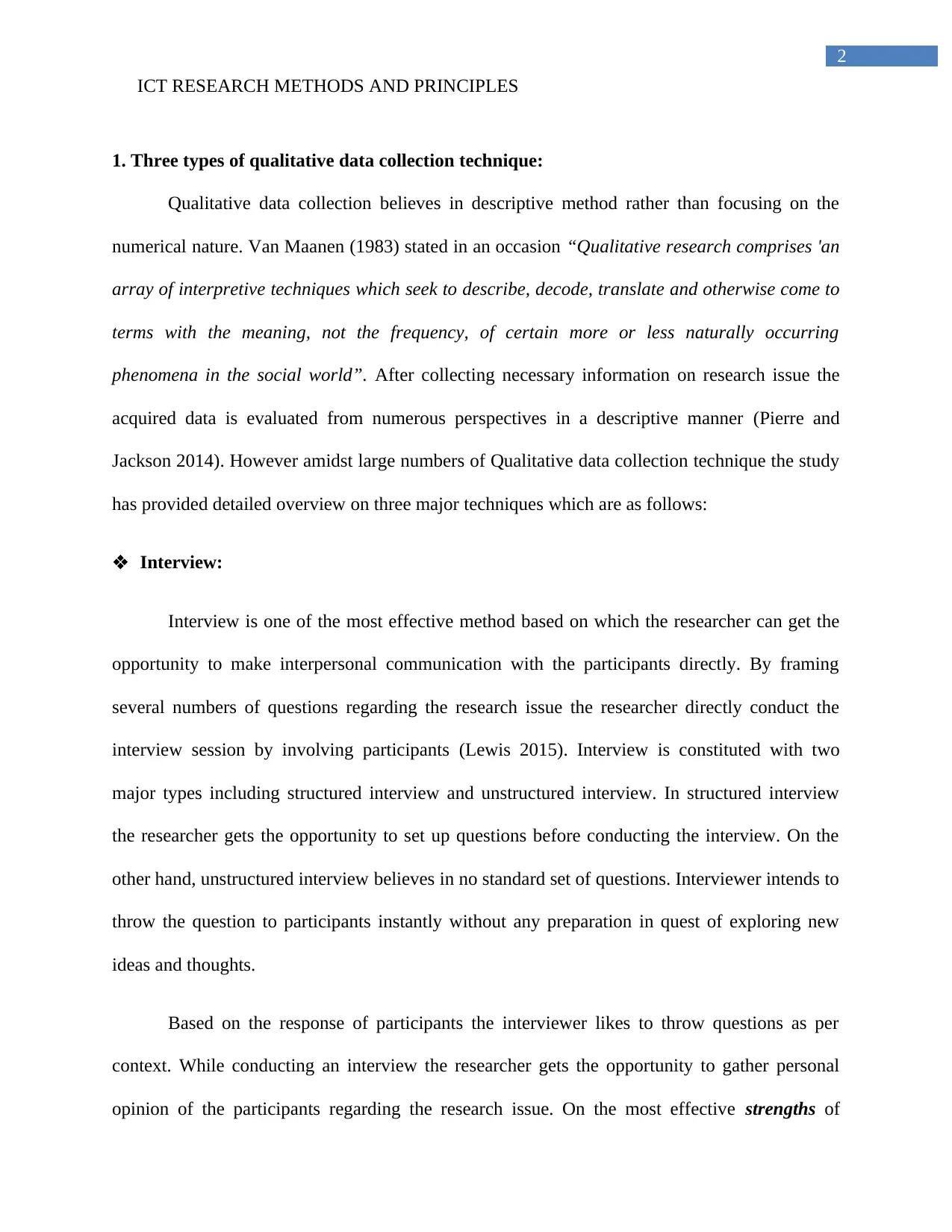
2
ICT RESEARCH METHODS AND PRINCIPLES
1. Three types of qualitative data collection technique:
Qualitative data collection believes in descriptive method rather than focusing on the
numerical nature. Van Maanen (1983) stated in an occasion “Qualitative research comprises 'an
array of interpretive techniques which seek to describe, decode, translate and otherwise come to
terms with the meaning, not the frequency, of certain more or less naturally occurring
phenomena in the social world”. After collecting necessary information on research issue the
acquired data is evaluated from numerous perspectives in a descriptive manner (Pierre and
Jackson 2014). However amidst large numbers of Qualitative data collection technique the study
has provided detailed overview on three major techniques which are as follows:
Interview:
Interview is one of the most effective method based on which the researcher can get the
opportunity to make interpersonal communication with the participants directly. By framing
several numbers of questions regarding the research issue the researcher directly conduct the
interview session by involving participants (Lewis 2015). Interview is constituted with two
major types including structured interview and unstructured interview. In structured interview
the researcher gets the opportunity to set up questions before conducting the interview. On the
other hand, unstructured interview believes in no standard set of questions. Interviewer intends to
throw the question to participants instantly without any preparation in quest of exploring new
ideas and thoughts.
Based on the response of participants the interviewer likes to throw questions as per
context. While conducting an interview the researcher gets the opportunity to gather personal
opinion of the participants regarding the research issue. On the most effective strengths of
ICT RESEARCH METHODS AND PRINCIPLES
1. Three types of qualitative data collection technique:
Qualitative data collection believes in descriptive method rather than focusing on the
numerical nature. Van Maanen (1983) stated in an occasion “Qualitative research comprises 'an
array of interpretive techniques which seek to describe, decode, translate and otherwise come to
terms with the meaning, not the frequency, of certain more or less naturally occurring
phenomena in the social world”. After collecting necessary information on research issue the
acquired data is evaluated from numerous perspectives in a descriptive manner (Pierre and
Jackson 2014). However amidst large numbers of Qualitative data collection technique the study
has provided detailed overview on three major techniques which are as follows:
Interview:
Interview is one of the most effective method based on which the researcher can get the
opportunity to make interpersonal communication with the participants directly. By framing
several numbers of questions regarding the research issue the researcher directly conduct the
interview session by involving participants (Lewis 2015). Interview is constituted with two
major types including structured interview and unstructured interview. In structured interview
the researcher gets the opportunity to set up questions before conducting the interview. On the
other hand, unstructured interview believes in no standard set of questions. Interviewer intends to
throw the question to participants instantly without any preparation in quest of exploring new
ideas and thoughts.
Based on the response of participants the interviewer likes to throw questions as per
context. While conducting an interview the researcher gets the opportunity to gather personal
opinion of the participants regarding the research issue. On the most effective strengths of
⊘ This is a preview!⊘
Do you want full access?
Subscribe today to unlock all pages.

Trusted by 1+ million students worldwide
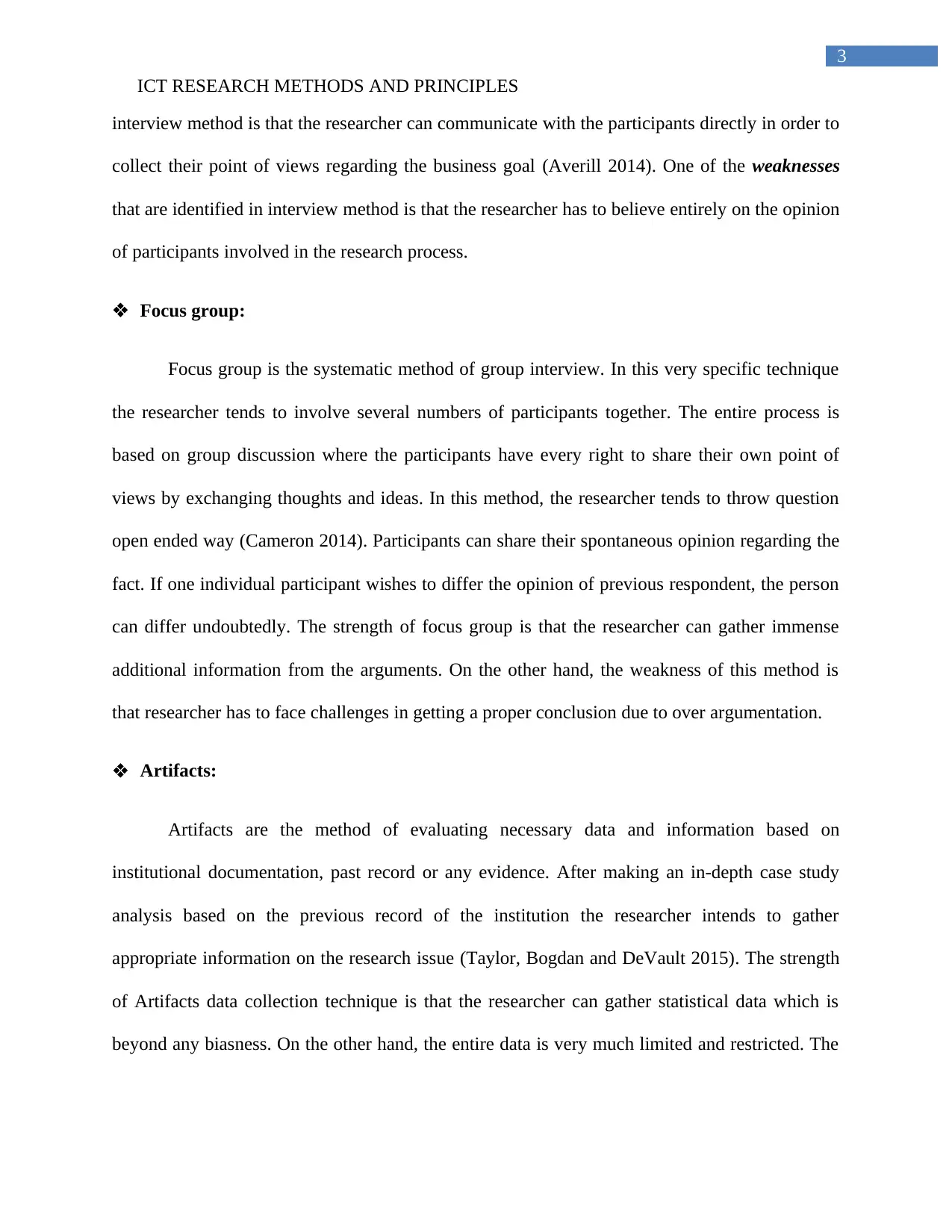
3
ICT RESEARCH METHODS AND PRINCIPLES
interview method is that the researcher can communicate with the participants directly in order to
collect their point of views regarding the business goal (Averill 2014). One of the weaknesses
that are identified in interview method is that the researcher has to believe entirely on the opinion
of participants involved in the research process.
Focus group:
Focus group is the systematic method of group interview. In this very specific technique
the researcher tends to involve several numbers of participants together. The entire process is
based on group discussion where the participants have every right to share their own point of
views by exchanging thoughts and ideas. In this method, the researcher tends to throw question
open ended way (Cameron 2014). Participants can share their spontaneous opinion regarding the
fact. If one individual participant wishes to differ the opinion of previous respondent, the person
can differ undoubtedly. The strength of focus group is that the researcher can gather immense
additional information from the arguments. On the other hand, the weakness of this method is
that researcher has to face challenges in getting a proper conclusion due to over argumentation.
Artifacts:
Artifacts are the method of evaluating necessary data and information based on
institutional documentation, past record or any evidence. After making an in-depth case study
analysis based on the previous record of the institution the researcher intends to gather
appropriate information on the research issue (Taylor, Bogdan and DeVault 2015). The strength
of Artifacts data collection technique is that the researcher can gather statistical data which is
beyond any biasness. On the other hand, the entire data is very much limited and restricted. The
ICT RESEARCH METHODS AND PRINCIPLES
interview method is that the researcher can communicate with the participants directly in order to
collect their point of views regarding the business goal (Averill 2014). One of the weaknesses
that are identified in interview method is that the researcher has to believe entirely on the opinion
of participants involved in the research process.
Focus group:
Focus group is the systematic method of group interview. In this very specific technique
the researcher tends to involve several numbers of participants together. The entire process is
based on group discussion where the participants have every right to share their own point of
views by exchanging thoughts and ideas. In this method, the researcher tends to throw question
open ended way (Cameron 2014). Participants can share their spontaneous opinion regarding the
fact. If one individual participant wishes to differ the opinion of previous respondent, the person
can differ undoubtedly. The strength of focus group is that the researcher can gather immense
additional information from the arguments. On the other hand, the weakness of this method is
that researcher has to face challenges in getting a proper conclusion due to over argumentation.
Artifacts:
Artifacts are the method of evaluating necessary data and information based on
institutional documentation, past record or any evidence. After making an in-depth case study
analysis based on the previous record of the institution the researcher intends to gather
appropriate information on the research issue (Taylor, Bogdan and DeVault 2015). The strength
of Artifacts data collection technique is that the researcher can gather statistical data which is
beyond any biasness. On the other hand, the entire data is very much limited and restricted. The
Paraphrase This Document
Need a fresh take? Get an instant paraphrase of this document with our AI Paraphraser
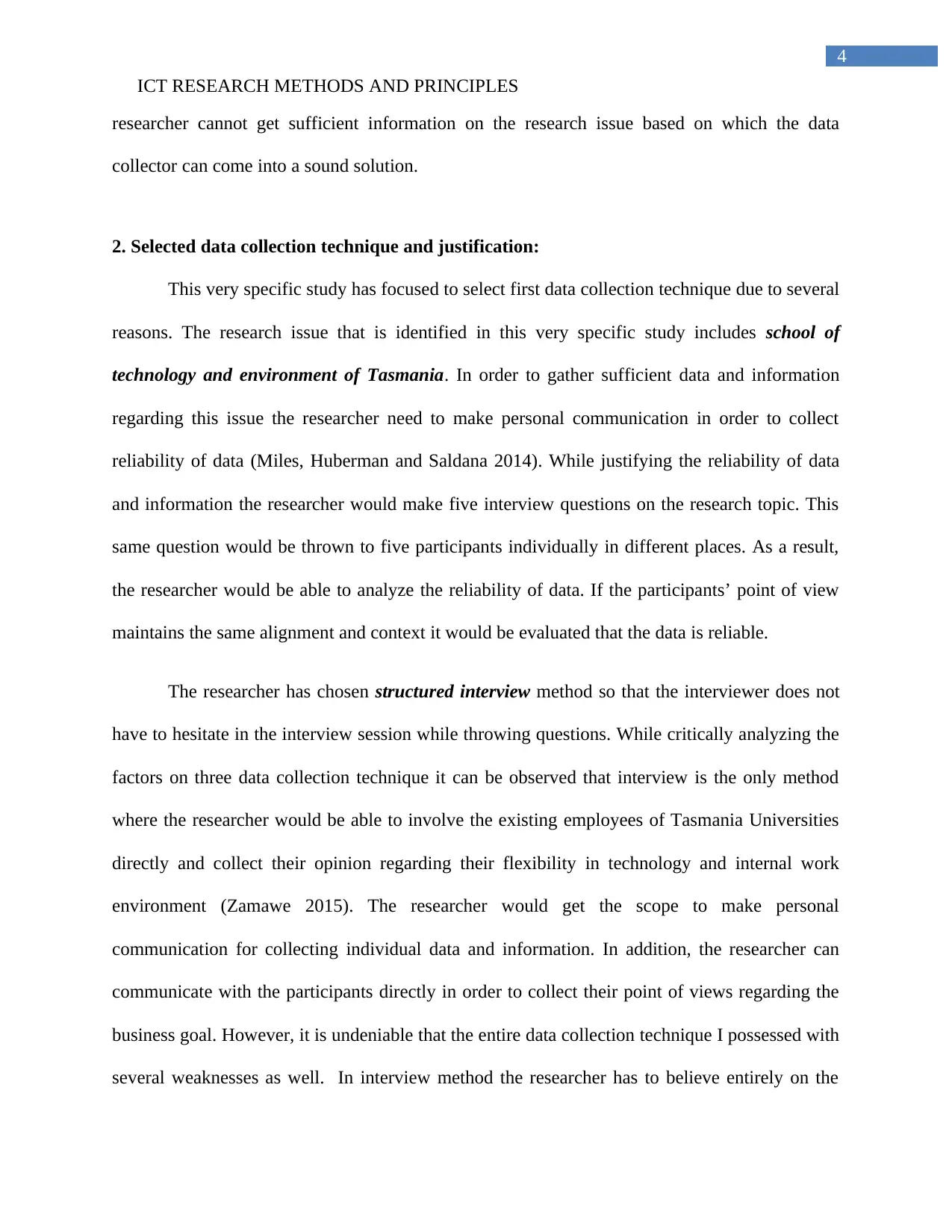
4
ICT RESEARCH METHODS AND PRINCIPLES
researcher cannot get sufficient information on the research issue based on which the data
collector can come into a sound solution.
2. Selected data collection technique and justification:
This very specific study has focused to select first data collection technique due to several
reasons. The research issue that is identified in this very specific study includes school of
technology and environment of Tasmania. In order to gather sufficient data and information
regarding this issue the researcher need to make personal communication in order to collect
reliability of data (Miles, Huberman and Saldana 2014). While justifying the reliability of data
and information the researcher would make five interview questions on the research topic. This
same question would be thrown to five participants individually in different places. As a result,
the researcher would be able to analyze the reliability of data. If the participants’ point of view
maintains the same alignment and context it would be evaluated that the data is reliable.
The researcher has chosen structured interview method so that the interviewer does not
have to hesitate in the interview session while throwing questions. While critically analyzing the
factors on three data collection technique it can be observed that interview is the only method
where the researcher would be able to involve the existing employees of Tasmania Universities
directly and collect their opinion regarding their flexibility in technology and internal work
environment (Zamawe 2015). The researcher would get the scope to make personal
communication for collecting individual data and information. In addition, the researcher can
communicate with the participants directly in order to collect their point of views regarding the
business goal. However, it is undeniable that the entire data collection technique I possessed with
several weaknesses as well. In interview method the researcher has to believe entirely on the
ICT RESEARCH METHODS AND PRINCIPLES
researcher cannot get sufficient information on the research issue based on which the data
collector can come into a sound solution.
2. Selected data collection technique and justification:
This very specific study has focused to select first data collection technique due to several
reasons. The research issue that is identified in this very specific study includes school of
technology and environment of Tasmania. In order to gather sufficient data and information
regarding this issue the researcher need to make personal communication in order to collect
reliability of data (Miles, Huberman and Saldana 2014). While justifying the reliability of data
and information the researcher would make five interview questions on the research topic. This
same question would be thrown to five participants individually in different places. As a result,
the researcher would be able to analyze the reliability of data. If the participants’ point of view
maintains the same alignment and context it would be evaluated that the data is reliable.
The researcher has chosen structured interview method so that the interviewer does not
have to hesitate in the interview session while throwing questions. While critically analyzing the
factors on three data collection technique it can be observed that interview is the only method
where the researcher would be able to involve the existing employees of Tasmania Universities
directly and collect their opinion regarding their flexibility in technology and internal work
environment (Zamawe 2015). The researcher would get the scope to make personal
communication for collecting individual data and information. In addition, the researcher can
communicate with the participants directly in order to collect their point of views regarding the
business goal. However, it is undeniable that the entire data collection technique I possessed with
several weaknesses as well. In interview method the researcher has to believe entirely on the
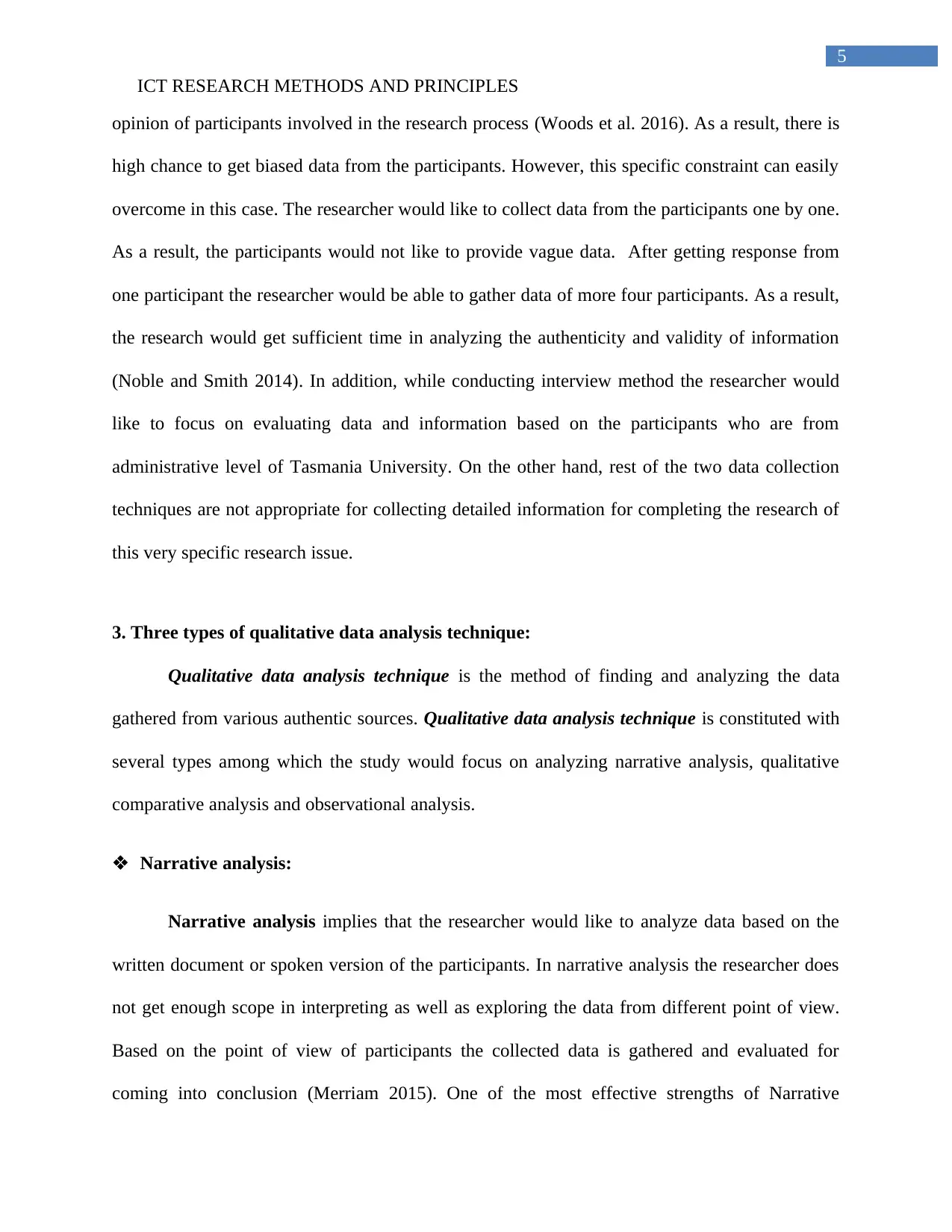
5
ICT RESEARCH METHODS AND PRINCIPLES
opinion of participants involved in the research process (Woods et al. 2016). As a result, there is
high chance to get biased data from the participants. However, this specific constraint can easily
overcome in this case. The researcher would like to collect data from the participants one by one.
As a result, the participants would not like to provide vague data. After getting response from
one participant the researcher would be able to gather data of more four participants. As a result,
the research would get sufficient time in analyzing the authenticity and validity of information
(Noble and Smith 2014). In addition, while conducting interview method the researcher would
like to focus on evaluating data and information based on the participants who are from
administrative level of Tasmania University. On the other hand, rest of the two data collection
techniques are not appropriate for collecting detailed information for completing the research of
this very specific research issue.
3. Three types of qualitative data analysis technique:
Qualitative data analysis technique is the method of finding and analyzing the data
gathered from various authentic sources. Qualitative data analysis technique is constituted with
several types among which the study would focus on analyzing narrative analysis, qualitative
comparative analysis and observational analysis.
Narrative analysis:
Narrative analysis implies that the researcher would like to analyze data based on the
written document or spoken version of the participants. In narrative analysis the researcher does
not get enough scope in interpreting as well as exploring the data from different point of view.
Based on the point of view of participants the collected data is gathered and evaluated for
coming into conclusion (Merriam 2015). One of the most effective strengths of Narrative
ICT RESEARCH METHODS AND PRINCIPLES
opinion of participants involved in the research process (Woods et al. 2016). As a result, there is
high chance to get biased data from the participants. However, this specific constraint can easily
overcome in this case. The researcher would like to collect data from the participants one by one.
As a result, the participants would not like to provide vague data. After getting response from
one participant the researcher would be able to gather data of more four participants. As a result,
the research would get sufficient time in analyzing the authenticity and validity of information
(Noble and Smith 2014). In addition, while conducting interview method the researcher would
like to focus on evaluating data and information based on the participants who are from
administrative level of Tasmania University. On the other hand, rest of the two data collection
techniques are not appropriate for collecting detailed information for completing the research of
this very specific research issue.
3. Three types of qualitative data analysis technique:
Qualitative data analysis technique is the method of finding and analyzing the data
gathered from various authentic sources. Qualitative data analysis technique is constituted with
several types among which the study would focus on analyzing narrative analysis, qualitative
comparative analysis and observational analysis.
Narrative analysis:
Narrative analysis implies that the researcher would like to analyze data based on the
written document or spoken version of the participants. In narrative analysis the researcher does
not get enough scope in interpreting as well as exploring the data from different point of view.
Based on the point of view of participants the collected data is gathered and evaluated for
coming into conclusion (Merriam 2015). One of the most effective strengths of Narrative
⊘ This is a preview!⊘
Do you want full access?
Subscribe today to unlock all pages.

Trusted by 1+ million students worldwide
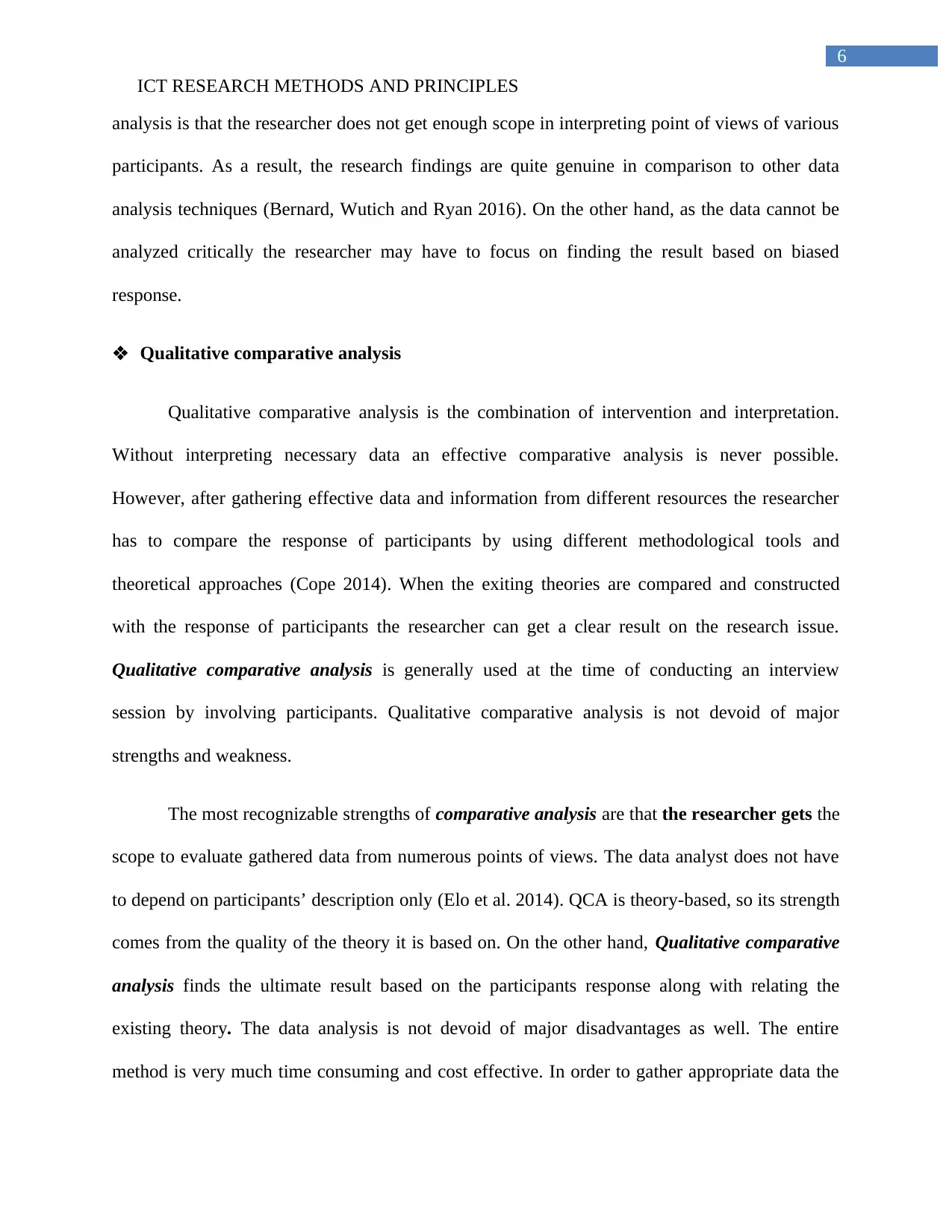
6
ICT RESEARCH METHODS AND PRINCIPLES
analysis is that the researcher does not get enough scope in interpreting point of views of various
participants. As a result, the research findings are quite genuine in comparison to other data
analysis techniques (Bernard, Wutich and Ryan 2016). On the other hand, as the data cannot be
analyzed critically the researcher may have to focus on finding the result based on biased
response.
Qualitative comparative analysis
Qualitative comparative analysis is the combination of intervention and interpretation.
Without interpreting necessary data an effective comparative analysis is never possible.
However, after gathering effective data and information from different resources the researcher
has to compare the response of participants by using different methodological tools and
theoretical approaches (Cope 2014). When the exiting theories are compared and constructed
with the response of participants the researcher can get a clear result on the research issue.
Qualitative comparative analysis is generally used at the time of conducting an interview
session by involving participants. Qualitative comparative analysis is not devoid of major
strengths and weakness.
The most recognizable strengths of comparative analysis are that the researcher gets the
scope to evaluate gathered data from numerous points of views. The data analyst does not have
to depend on participants’ description only (Elo et al. 2014). QCA is theory-based, so its strength
comes from the quality of the theory it is based on. On the other hand, Qualitative comparative
analysis finds the ultimate result based on the participants response along with relating the
existing theory. The data analysis is not devoid of major disadvantages as well. The entire
method is very much time consuming and cost effective. In order to gather appropriate data the
ICT RESEARCH METHODS AND PRINCIPLES
analysis is that the researcher does not get enough scope in interpreting point of views of various
participants. As a result, the research findings are quite genuine in comparison to other data
analysis techniques (Bernard, Wutich and Ryan 2016). On the other hand, as the data cannot be
analyzed critically the researcher may have to focus on finding the result based on biased
response.
Qualitative comparative analysis
Qualitative comparative analysis is the combination of intervention and interpretation.
Without interpreting necessary data an effective comparative analysis is never possible.
However, after gathering effective data and information from different resources the researcher
has to compare the response of participants by using different methodological tools and
theoretical approaches (Cope 2014). When the exiting theories are compared and constructed
with the response of participants the researcher can get a clear result on the research issue.
Qualitative comparative analysis is generally used at the time of conducting an interview
session by involving participants. Qualitative comparative analysis is not devoid of major
strengths and weakness.
The most recognizable strengths of comparative analysis are that the researcher gets the
scope to evaluate gathered data from numerous points of views. The data analyst does not have
to depend on participants’ description only (Elo et al. 2014). QCA is theory-based, so its strength
comes from the quality of the theory it is based on. On the other hand, Qualitative comparative
analysis finds the ultimate result based on the participants response along with relating the
existing theory. The data analysis is not devoid of major disadvantages as well. The entire
method is very much time consuming and cost effective. In order to gather appropriate data the
Paraphrase This Document
Need a fresh take? Get an instant paraphrase of this document with our AI Paraphraser
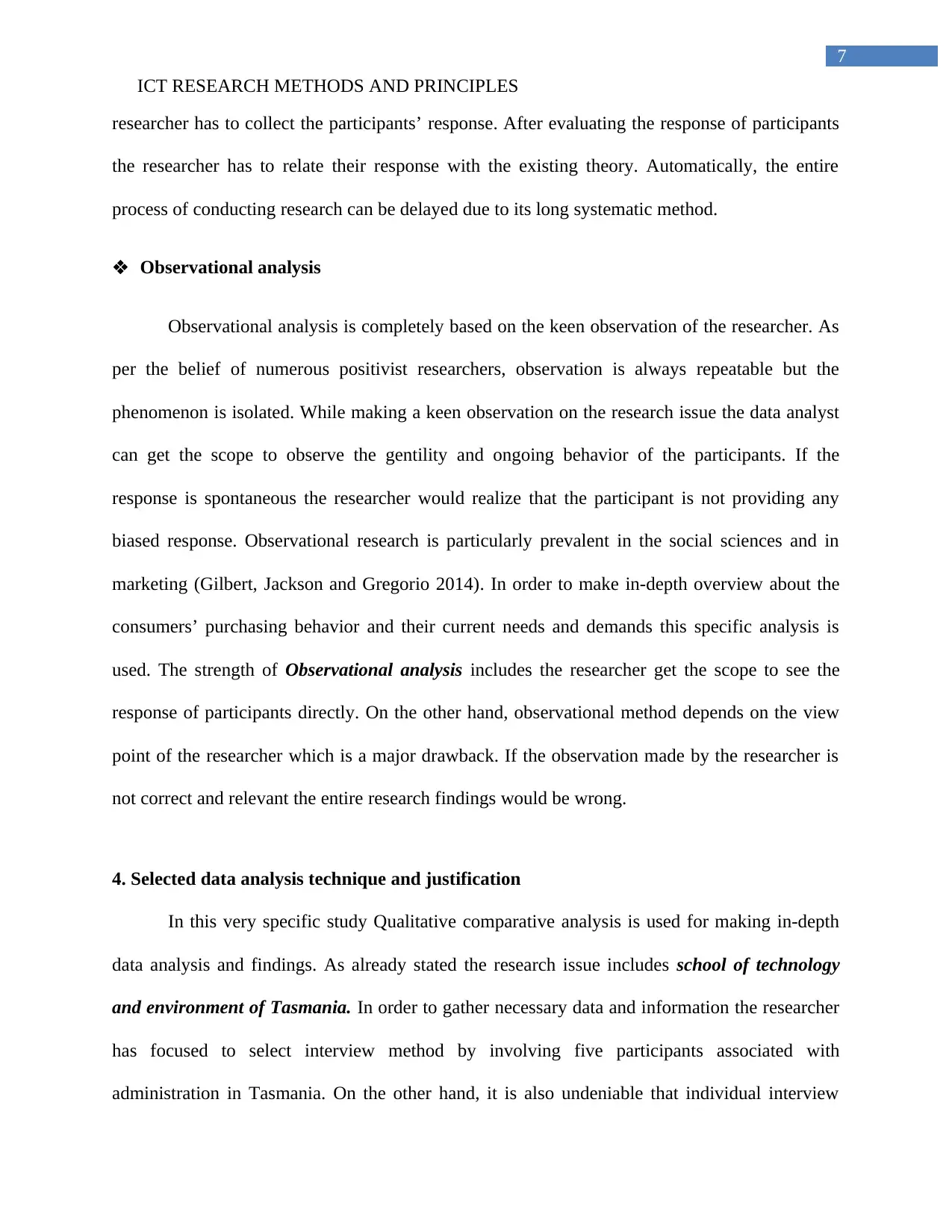
7
ICT RESEARCH METHODS AND PRINCIPLES
researcher has to collect the participants’ response. After evaluating the response of participants
the researcher has to relate their response with the existing theory. Automatically, the entire
process of conducting research can be delayed due to its long systematic method.
Observational analysis
Observational analysis is completely based on the keen observation of the researcher. As
per the belief of numerous positivist researchers, observation is always repeatable but the
phenomenon is isolated. While making a keen observation on the research issue the data analyst
can get the scope to observe the gentility and ongoing behavior of the participants. If the
response is spontaneous the researcher would realize that the participant is not providing any
biased response. Observational research is particularly prevalent in the social sciences and in
marketing (Gilbert, Jackson and Gregorio 2014). In order to make in-depth overview about the
consumers’ purchasing behavior and their current needs and demands this specific analysis is
used. The strength of Observational analysis includes the researcher get the scope to see the
response of participants directly. On the other hand, observational method depends on the view
point of the researcher which is a major drawback. If the observation made by the researcher is
not correct and relevant the entire research findings would be wrong.
4. Selected data analysis technique and justification
In this very specific study Qualitative comparative analysis is used for making in-depth
data analysis and findings. As already stated the research issue includes school of technology
and environment of Tasmania. In order to gather necessary data and information the researcher
has focused to select interview method by involving five participants associated with
administration in Tasmania. On the other hand, it is also undeniable that individual interview
ICT RESEARCH METHODS AND PRINCIPLES
researcher has to collect the participants’ response. After evaluating the response of participants
the researcher has to relate their response with the existing theory. Automatically, the entire
process of conducting research can be delayed due to its long systematic method.
Observational analysis
Observational analysis is completely based on the keen observation of the researcher. As
per the belief of numerous positivist researchers, observation is always repeatable but the
phenomenon is isolated. While making a keen observation on the research issue the data analyst
can get the scope to observe the gentility and ongoing behavior of the participants. If the
response is spontaneous the researcher would realize that the participant is not providing any
biased response. Observational research is particularly prevalent in the social sciences and in
marketing (Gilbert, Jackson and Gregorio 2014). In order to make in-depth overview about the
consumers’ purchasing behavior and their current needs and demands this specific analysis is
used. The strength of Observational analysis includes the researcher get the scope to see the
response of participants directly. On the other hand, observational method depends on the view
point of the researcher which is a major drawback. If the observation made by the researcher is
not correct and relevant the entire research findings would be wrong.
4. Selected data analysis technique and justification
In this very specific study Qualitative comparative analysis is used for making in-depth
data analysis and findings. As already stated the research issue includes school of technology
and environment of Tasmania. In order to gather necessary data and information the researcher
has focused to select interview method by involving five participants associated with
administration in Tasmania. On the other hand, it is also undeniable that individual interview
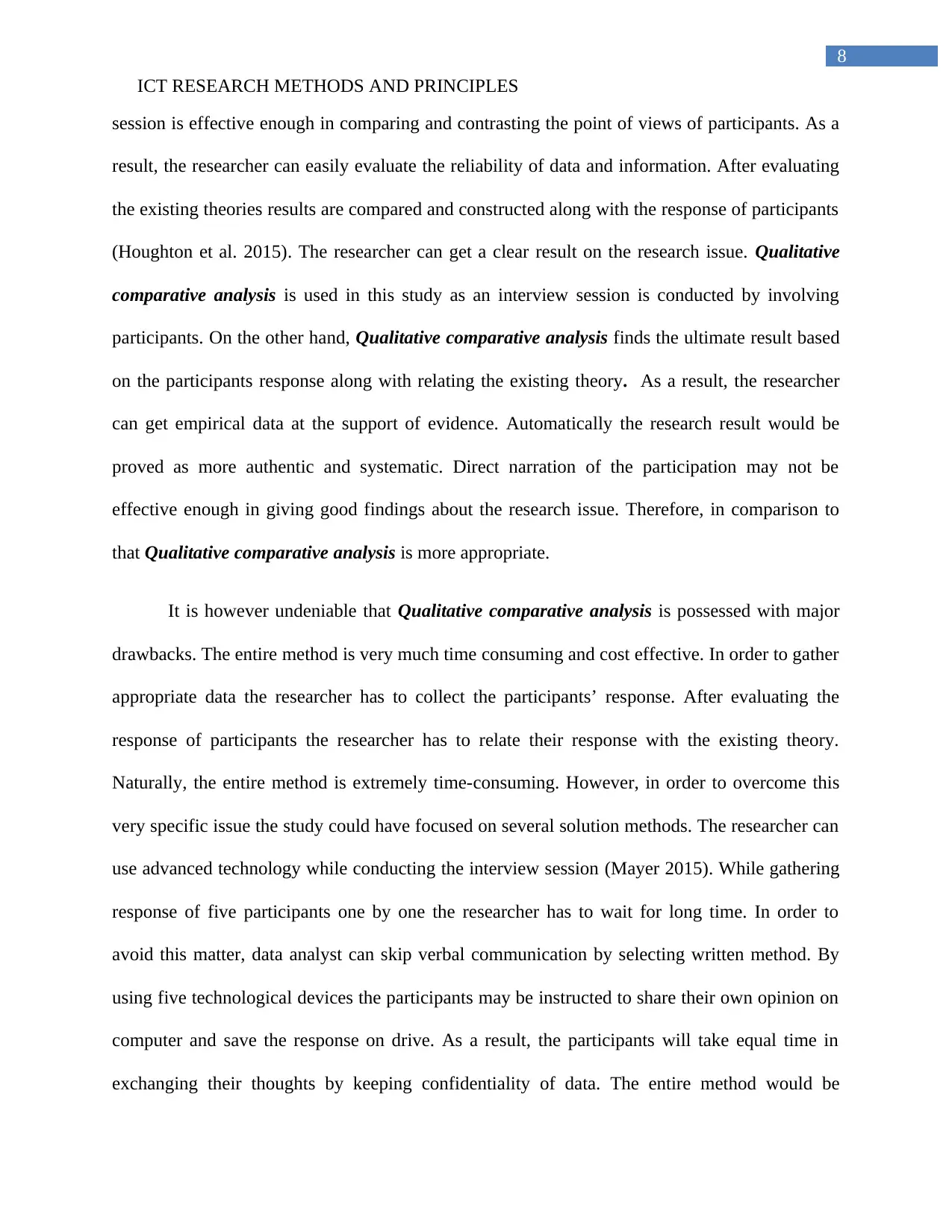
8
ICT RESEARCH METHODS AND PRINCIPLES
session is effective enough in comparing and contrasting the point of views of participants. As a
result, the researcher can easily evaluate the reliability of data and information. After evaluating
the existing theories results are compared and constructed along with the response of participants
(Houghton et al. 2015). The researcher can get a clear result on the research issue. Qualitative
comparative analysis is used in this study as an interview session is conducted by involving
participants. On the other hand, Qualitative comparative analysis finds the ultimate result based
on the participants response along with relating the existing theory. As a result, the researcher
can get empirical data at the support of evidence. Automatically the research result would be
proved as more authentic and systematic. Direct narration of the participation may not be
effective enough in giving good findings about the research issue. Therefore, in comparison to
that Qualitative comparative analysis is more appropriate.
It is however undeniable that Qualitative comparative analysis is possessed with major
drawbacks. The entire method is very much time consuming and cost effective. In order to gather
appropriate data the researcher has to collect the participants’ response. After evaluating the
response of participants the researcher has to relate their response with the existing theory.
Naturally, the entire method is extremely time-consuming. However, in order to overcome this
very specific issue the study could have focused on several solution methods. The researcher can
use advanced technology while conducting the interview session (Mayer 2015). While gathering
response of five participants one by one the researcher has to wait for long time. In order to
avoid this matter, data analyst can skip verbal communication by selecting written method. By
using five technological devices the participants may be instructed to share their own opinion on
computer and save the response on drive. As a result, the participants will take equal time in
exchanging their thoughts by keeping confidentiality of data. The entire method would be
ICT RESEARCH METHODS AND PRINCIPLES
session is effective enough in comparing and contrasting the point of views of participants. As a
result, the researcher can easily evaluate the reliability of data and information. After evaluating
the existing theories results are compared and constructed along with the response of participants
(Houghton et al. 2015). The researcher can get a clear result on the research issue. Qualitative
comparative analysis is used in this study as an interview session is conducted by involving
participants. On the other hand, Qualitative comparative analysis finds the ultimate result based
on the participants response along with relating the existing theory. As a result, the researcher
can get empirical data at the support of evidence. Automatically the research result would be
proved as more authentic and systematic. Direct narration of the participation may not be
effective enough in giving good findings about the research issue. Therefore, in comparison to
that Qualitative comparative analysis is more appropriate.
It is however undeniable that Qualitative comparative analysis is possessed with major
drawbacks. The entire method is very much time consuming and cost effective. In order to gather
appropriate data the researcher has to collect the participants’ response. After evaluating the
response of participants the researcher has to relate their response with the existing theory.
Naturally, the entire method is extremely time-consuming. However, in order to overcome this
very specific issue the study could have focused on several solution methods. The researcher can
use advanced technology while conducting the interview session (Mayer 2015). While gathering
response of five participants one by one the researcher has to wait for long time. In order to
avoid this matter, data analyst can skip verbal communication by selecting written method. By
using five technological devices the participants may be instructed to share their own opinion on
computer and save the response on drive. As a result, the participants will take equal time in
exchanging their thoughts by keeping confidentiality of data. The entire method would be
⊘ This is a preview!⊘
Do you want full access?
Subscribe today to unlock all pages.

Trusted by 1+ million students worldwide

9
ICT RESEARCH METHODS AND PRINCIPLES
conducted very fast. Automatically, the research would not have to invest large amount of time
for analyzing the response of participants. Therefore, the decision of selecting Qualitative
comparative analysis is justified for this study.
ICT RESEARCH METHODS AND PRINCIPLES
conducted very fast. Automatically, the research would not have to invest large amount of time
for analyzing the response of participants. Therefore, the decision of selecting Qualitative
comparative analysis is justified for this study.
Paraphrase This Document
Need a fresh take? Get an instant paraphrase of this document with our AI Paraphraser
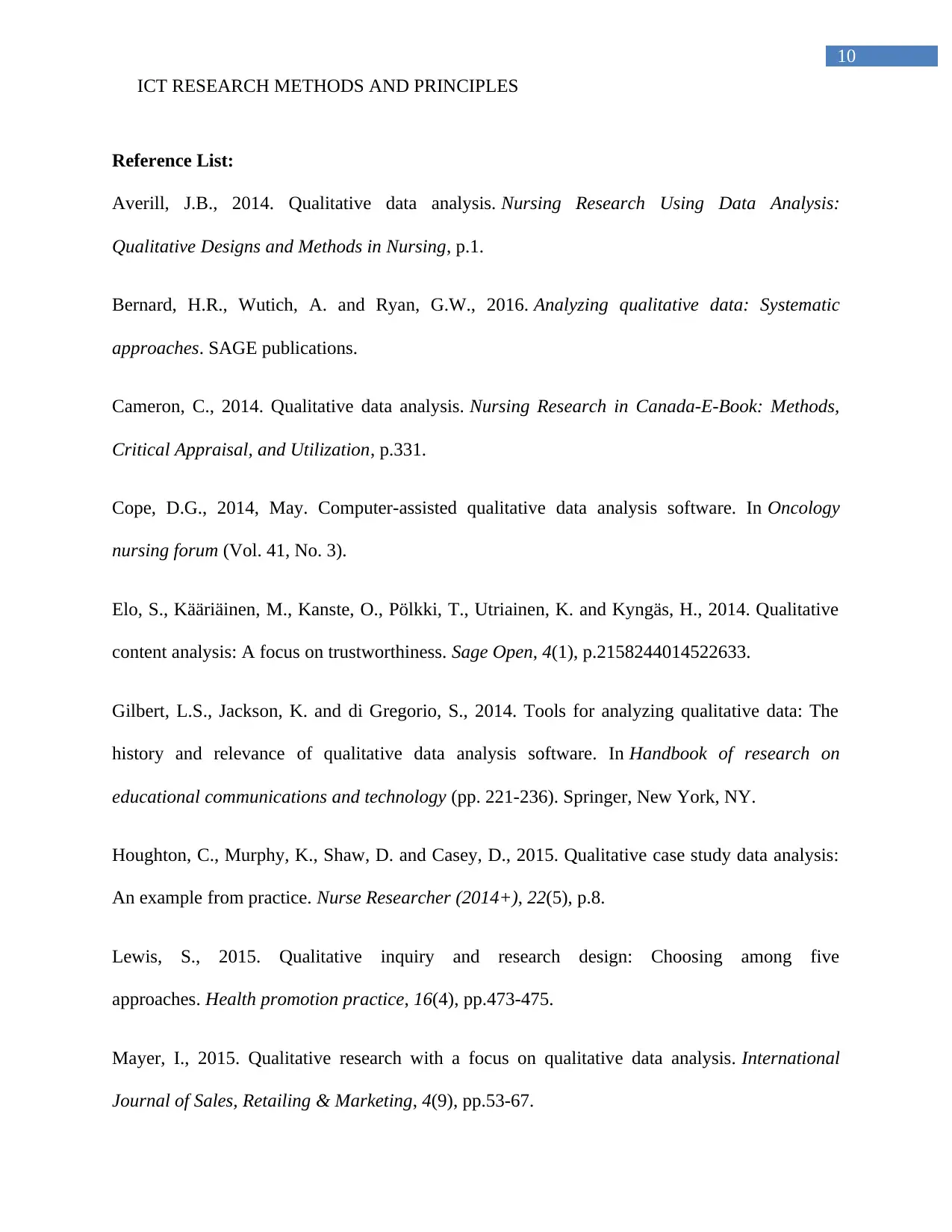
10
ICT RESEARCH METHODS AND PRINCIPLES
Reference List:
Averill, J.B., 2014. Qualitative data analysis. Nursing Research Using Data Analysis:
Qualitative Designs and Methods in Nursing, p.1.
Bernard, H.R., Wutich, A. and Ryan, G.W., 2016. Analyzing qualitative data: Systematic
approaches. SAGE publications.
Cameron, C., 2014. Qualitative data analysis. Nursing Research in Canada-E-Book: Methods,
Critical Appraisal, and Utilization, p.331.
Cope, D.G., 2014, May. Computer-assisted qualitative data analysis software. In Oncology
nursing forum (Vol. 41, No. 3).
Elo, S., Kääriäinen, M., Kanste, O., Pölkki, T., Utriainen, K. and Kyngäs, H., 2014. Qualitative
content analysis: A focus on trustworthiness. Sage Open, 4(1), p.2158244014522633.
Gilbert, L.S., Jackson, K. and di Gregorio, S., 2014. Tools for analyzing qualitative data: The
history and relevance of qualitative data analysis software. In Handbook of research on
educational communications and technology (pp. 221-236). Springer, New York, NY.
Houghton, C., Murphy, K., Shaw, D. and Casey, D., 2015. Qualitative case study data analysis:
An example from practice. Nurse Researcher (2014+), 22(5), p.8.
Lewis, S., 2015. Qualitative inquiry and research design: Choosing among five
approaches. Health promotion practice, 16(4), pp.473-475.
Mayer, I., 2015. Qualitative research with a focus on qualitative data analysis. International
Journal of Sales, Retailing & Marketing, 4(9), pp.53-67.
ICT RESEARCH METHODS AND PRINCIPLES
Reference List:
Averill, J.B., 2014. Qualitative data analysis. Nursing Research Using Data Analysis:
Qualitative Designs and Methods in Nursing, p.1.
Bernard, H.R., Wutich, A. and Ryan, G.W., 2016. Analyzing qualitative data: Systematic
approaches. SAGE publications.
Cameron, C., 2014. Qualitative data analysis. Nursing Research in Canada-E-Book: Methods,
Critical Appraisal, and Utilization, p.331.
Cope, D.G., 2014, May. Computer-assisted qualitative data analysis software. In Oncology
nursing forum (Vol. 41, No. 3).
Elo, S., Kääriäinen, M., Kanste, O., Pölkki, T., Utriainen, K. and Kyngäs, H., 2014. Qualitative
content analysis: A focus on trustworthiness. Sage Open, 4(1), p.2158244014522633.
Gilbert, L.S., Jackson, K. and di Gregorio, S., 2014. Tools for analyzing qualitative data: The
history and relevance of qualitative data analysis software. In Handbook of research on
educational communications and technology (pp. 221-236). Springer, New York, NY.
Houghton, C., Murphy, K., Shaw, D. and Casey, D., 2015. Qualitative case study data analysis:
An example from practice. Nurse Researcher (2014+), 22(5), p.8.
Lewis, S., 2015. Qualitative inquiry and research design: Choosing among five
approaches. Health promotion practice, 16(4), pp.473-475.
Mayer, I., 2015. Qualitative research with a focus on qualitative data analysis. International
Journal of Sales, Retailing & Marketing, 4(9), pp.53-67.
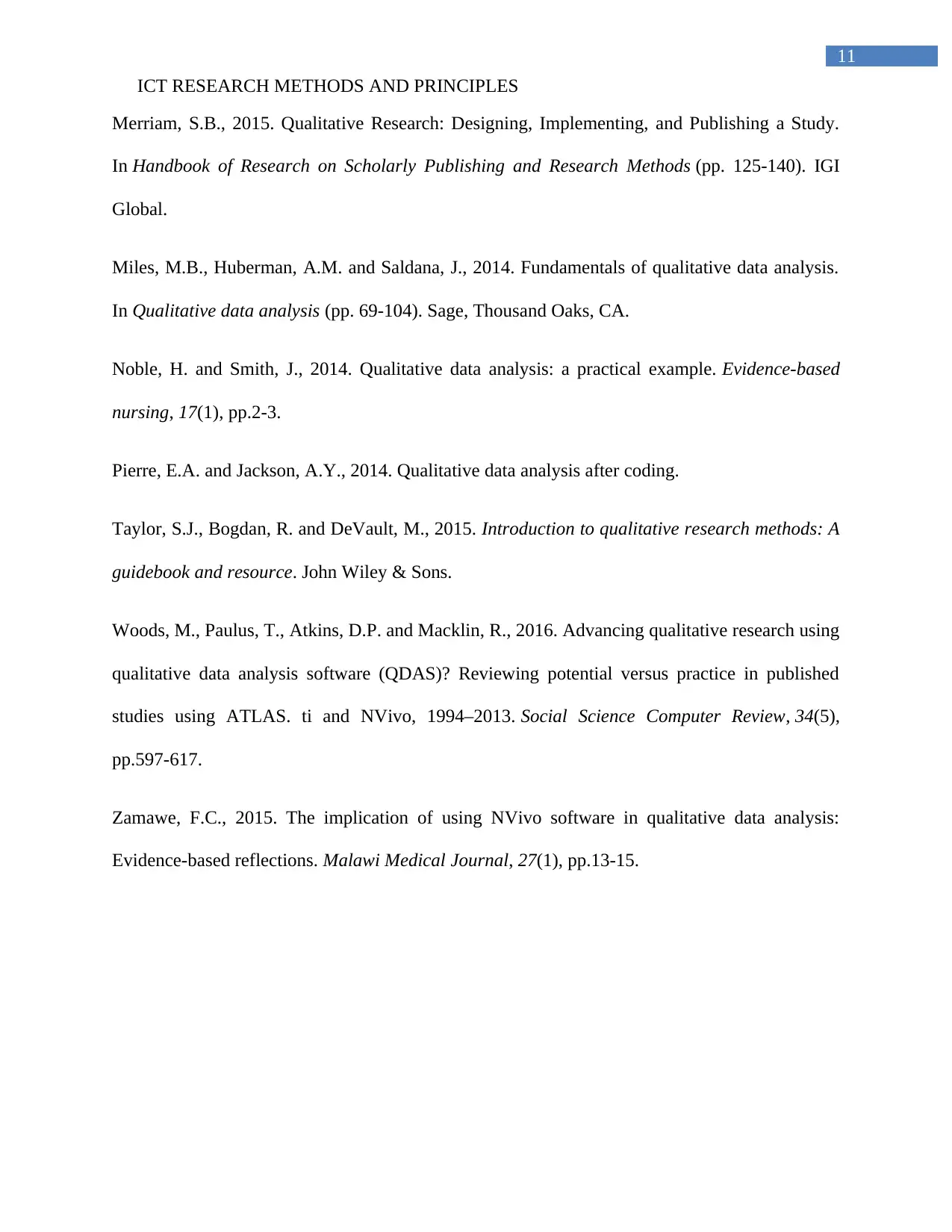
11
ICT RESEARCH METHODS AND PRINCIPLES
Merriam, S.B., 2015. Qualitative Research: Designing, Implementing, and Publishing a Study.
In Handbook of Research on Scholarly Publishing and Research Methods (pp. 125-140). IGI
Global.
Miles, M.B., Huberman, A.M. and Saldana, J., 2014. Fundamentals of qualitative data analysis.
In Qualitative data analysis (pp. 69-104). Sage, Thousand Oaks, CA.
Noble, H. and Smith, J., 2014. Qualitative data analysis: a practical example. Evidence-based
nursing, 17(1), pp.2-3.
Pierre, E.A. and Jackson, A.Y., 2014. Qualitative data analysis after coding.
Taylor, S.J., Bogdan, R. and DeVault, M., 2015. Introduction to qualitative research methods: A
guidebook and resource. John Wiley & Sons.
Woods, M., Paulus, T., Atkins, D.P. and Macklin, R., 2016. Advancing qualitative research using
qualitative data analysis software (QDAS)? Reviewing potential versus practice in published
studies using ATLAS. ti and NVivo, 1994–2013. Social Science Computer Review, 34(5),
pp.597-617.
Zamawe, F.C., 2015. The implication of using NVivo software in qualitative data analysis:
Evidence-based reflections. Malawi Medical Journal, 27(1), pp.13-15.
ICT RESEARCH METHODS AND PRINCIPLES
Merriam, S.B., 2015. Qualitative Research: Designing, Implementing, and Publishing a Study.
In Handbook of Research on Scholarly Publishing and Research Methods (pp. 125-140). IGI
Global.
Miles, M.B., Huberman, A.M. and Saldana, J., 2014. Fundamentals of qualitative data analysis.
In Qualitative data analysis (pp. 69-104). Sage, Thousand Oaks, CA.
Noble, H. and Smith, J., 2014. Qualitative data analysis: a practical example. Evidence-based
nursing, 17(1), pp.2-3.
Pierre, E.A. and Jackson, A.Y., 2014. Qualitative data analysis after coding.
Taylor, S.J., Bogdan, R. and DeVault, M., 2015. Introduction to qualitative research methods: A
guidebook and resource. John Wiley & Sons.
Woods, M., Paulus, T., Atkins, D.P. and Macklin, R., 2016. Advancing qualitative research using
qualitative data analysis software (QDAS)? Reviewing potential versus practice in published
studies using ATLAS. ti and NVivo, 1994–2013. Social Science Computer Review, 34(5),
pp.597-617.
Zamawe, F.C., 2015. The implication of using NVivo software in qualitative data analysis:
Evidence-based reflections. Malawi Medical Journal, 27(1), pp.13-15.
⊘ This is a preview!⊘
Do you want full access?
Subscribe today to unlock all pages.

Trusted by 1+ million students worldwide
1 out of 12
Related Documents
Your All-in-One AI-Powered Toolkit for Academic Success.
+13062052269
info@desklib.com
Available 24*7 on WhatsApp / Email
![[object Object]](/_next/static/media/star-bottom.7253800d.svg)
Unlock your academic potential
Copyright © 2020–2025 A2Z Services. All Rights Reserved. Developed and managed by ZUCOL.





